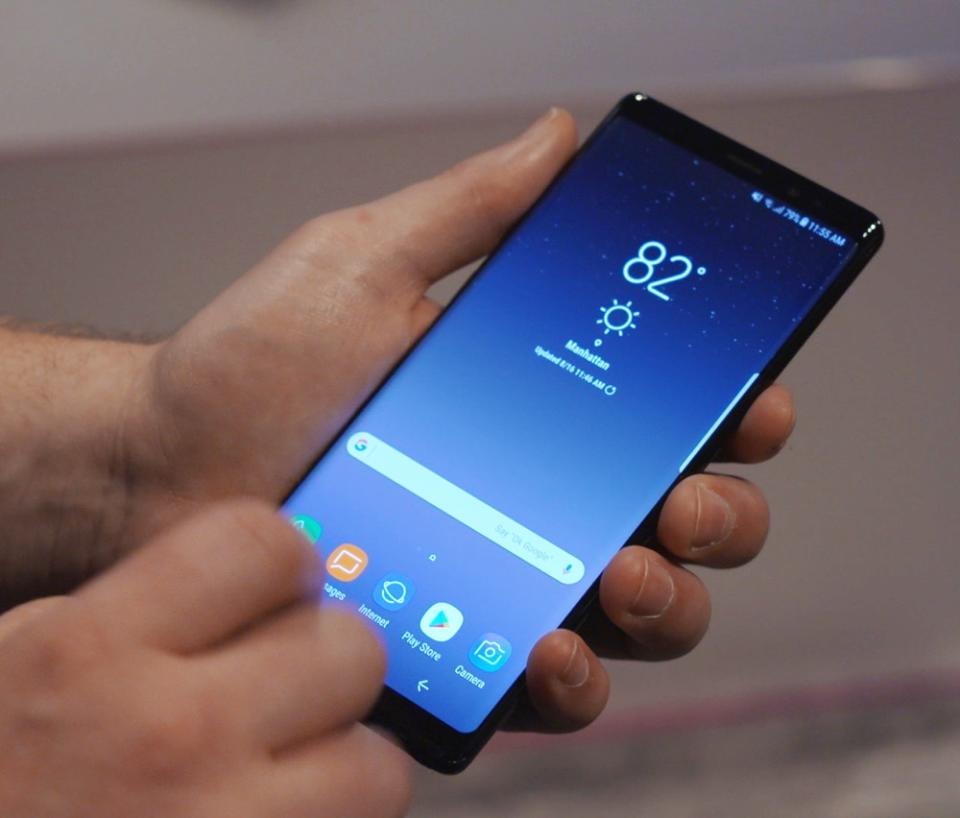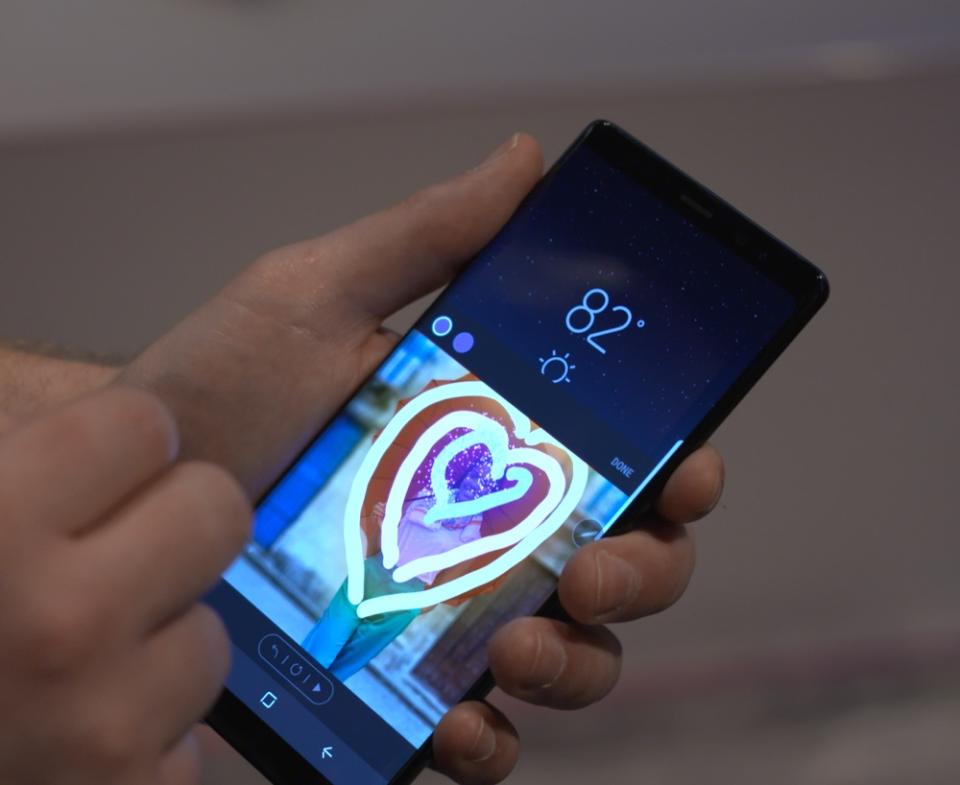Samsung Galaxy Note 8 review: A big phone with bigger expectations
Samsung’s Galaxy Note 8, the follow-up to the Note 7 — or as it’s more commonly called, one of the worst public relations disasters in the history of consumer electronics — is finally here. And it’s quite the encore.
Not only has the handset been completely redesigned from the Note 7, but it’s also got a larger display and, more importantly, a new dual-lens rear camera designed specifically to take on Apple’s iPhone 7 Plus.
But the Note 8 looks to have some stiff competition in Apple’s (AAPL) upcoming iPhone 8. Samsung’s handset, however, offers plenty of appealing features including a gorgeous display, impressive performance and, best of all, a battery Samsung says won’t explode. It’s certainly a fantastic smartphone, but might not be for everyone, especially if you don’t want to spend nearly $1,000.
Copy and paste
The Galaxy Note 8 takes nearly all of its design cues from Samsung’s Galaxy S8 and S8 Plus. The handset is a sleek, rectangular piece of aluminum and glass with sharper edges than the S8 and S8 Plus. But beyond that, the three phones are all incredibly similar.
In fact, the Note 8 and S8 Plus, in particular, look nearly identical. That’s because the Note 8 sports a 6.3-inch display, while the S8 Plus packs a 6.2-inch panel. That’s a bit odd since Samsung has always used the Note brand’s extra large screens to differentiate it from its Galaxy line of handsets.

I’ve got both the Note 8 and S8 Plus at my desk and frequently confuse the two. That won’t be a problem for most people, obviously, but it does mean consumers will question why they need to buy one phone over the other if they’re just looking for a big screen.
That said, the Note 8’s Super AMOLED Infinite Display with its wraparound edges is as gorgeous as a smartphone screen can get. Colors are bright and vivid and blacks are almost as deep as the phone’s bezel, making for a nearly seamless viewing experience.
S Pen stylus
Beyond its huge display, Samsung uses the Note 8’s stylus to help its handset stand out from the pack. With the S8 Plus and the Note 8 so close in size, Samsung is leaning more heavily on the S Pen stylus to push the phone.

As with the Note 7, the Note 8’s stylus allows you to take on-screen notes without turning on the phone’s display, by simply removing the pen from its holder while the screen is off.
But rather than letting you take just one page of notes, Samsung now lets you take 100. That’s pretty helpful if you’re the type of person who needs to write things down to remember them 10 minutes later. (Like me.)
Dual lenses
So if the Note 8’s display size isn’t unique anymore, and the S Pen stylus doesn’t quite do it for everyone, what’s the phone’s biggest selling point? How about its dual-lens camera? Yes, like Apple, Motorola, Essential and others, Samsung has slapped an extra lens on its smartphone.
But unlike Essential and Motorola, which use their secondary camera to capture black and white images in addition to color for improved contrast, Samsung, like Apple, uses its second lens for optical zoom.
The Note 8, like the iPhone 7 Plus, has both wide-angle and telephoto lenses. But unlike the iPhone 7 Plus, the Note 8 has outfitted both lenses with optical image stabilization (OIS). OIS is what helps keep your images looking nice and stable even when your hand is shaking.

It’s great to have that on the wide angle lens, as that’s the most commonly used, but it’s even more important for the telephoto lens, since movement is far more exaggerated when zoomed in on a subject. The difference between the two handsets’ live image preview is really something to see.
Samsung’s Note 8 also comes with what the company calls Live Focus, which lets you take photos of a subject while blurring the background, also known as a bokeh effect. It’s a nice look that Apple also offers with the iPhone 7 Plus.
Both cameras do a good job of blurring the background to create a depth of field effect, but the iPhone’s looks more natural while the Note 8’s looks artificial. Even with the added ability to edit the effect taking your photo with the Note, it couldn’t match the iPhone.
Still, the Note images weren’t unattractive, and both phones struggled when it came to trying to implement the effect with objects that had multiple angles like large flower bushes.
In general, the Note’s photos were far more saturated than the iPhone’s, which offered a neutral look. Still, Apple’s phone struggled in low-light settings, causing pixilated images, where Samsung’s didn’t.
Bixby says “Hi”
Apple’s got Siri, Google’s got its Assistant and now Samsung’s got Bixby. The company’s virtual assistant is designed to let you do everything from open apps on your phone to ask who starred in “The Lord of the Rings.”
Bixby also features a Home screen similar to Google’s Android app that gives you updates on news stories, nearby attractions, your schedule, the weather, YouTube updates, and Google Music.
Bixby seemed to understand me well enough most of the time, but the results I received weren’t as detailed as those provided by Google’s Assistant or Siri. The app also asks you to “teach” Bixby if it doesn’t understand something, a result of Samsung still needing to feed the assistant data to improve its responses.
Samsung is positioning Bixby as a means to navigate your phone more quickly using your voice by allowing you to tell it to do things like open specific apps. Google and Apple can already do this with their respective assistants, but Samsung is also going to have to ensure that third-party developers make their apps work with Bixby to get the most functionality out of the service.
Big power
The Note 8 is powered by the same 8-core processor found in the Galaxy S8, 6 GB of RAM and 64 GB of storage with the option to expand it via a microSD card slot. All of that is to say the Note 8 is quite the powerhouse.
More importantly, the Note 8 has a completely different battery from the one found in the Note 7. In fact, Samsung went so far as to have the 8’s battery certified by the Underwriters Laboratory to ensure its safety.
In terms of the Note 8’s battery capacity, I managed to use the handset for about a day and a half without having to recharge it, similar to Apple’s iPhone 7 Plus. But unlike Apple’s handset, the Note 8 offers fast-charging technology, so you can juice up the phone much faster than the iPhone.
As with the Galaxy S8, the Note 8 comes with a fingerprint sensor and iris scanner, but the Note ups the ante with a new face scanner. There are some issues with the three, though. The fingerprint scanner is located next to the camera, which makes it a bit annoying to tap without also touching the camera’s lens. The iris and face scanners also worked well, but if you have glasses and contacts on, the iris scanner can have difficulty recognizing your eyes.
The face scanner, meanwhile, was hit or miss when I put my glasses on and took them off. There were times when the scanner recognized my face and unlocked the phone and others where it couldn’t tell who I was at all.
Should you get it?
The Note 8 is a beautiful, if overly familiar smartphone, with a fantastic display, long-lasting battery and solid camera. But at between $930 and $960, depending on your carrier of choice, it’s also expensive. The Galaxy S8 Plus, on the other hand, which has a similar look, display and battery life, costs $824.
If, however, you’re a fan of the Note 8’s stylus and dual-lens camera, and don’t have a problem with the handset’s price, then Samsung’s big beast is a fantastic device. If you don’t want to drop that much cash, but need a bigger screen, then the S8 Plus is the right choice for you.
More from Dan:
‘Mario + Rabbids Kingdom Battle’ review: An insane mix of strategy and absurdity
Fitbit’s Ionic smartwatch is here to take on the Apple Watch
Email Daniel at [email protected]; follow him on Twitter at @DanielHowley.
